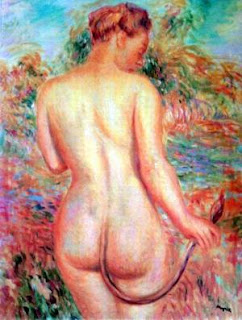The artist in question is one Roy Lichtenstein, and his four works are as follows:
 |
| "Drowning Girl" 1963 |
 |
| "In The Car" 1963 |
 |
| "Torpedo...Los!" 1963 |
 |
| "Whaam!" 1963 |
Lichtenstein had a penchant for making works based on comic strip panels. In fact, each of these works is based on existing panels. I feel the best way to represent them is to go through each one individually. So let's do that!
"Drowning Girl" - Derived from Tony Abruzzo's panel in "Run For Love" from DC Comics' Secret Hearts #83. Lichtenstein's painting is cropped significantly, omitting the entire scene occurring, and opting instead to just show the girl's face. In addition, the text was changed from "I don't care if I have a cramp! I'd rather sink than call Mel for help!" to "I don't care-- I'd rather sink than call Brad for help!" Lichtenstein has stated the intention of this piece being to depict extreme melodrama. Even the decision to change the boyfriend's name to Brad was in service of this. Lichtenstein felt that Brad was a more cliche'd heroic boyfriend name.
"In The Car" - Based on a panel from edition #78 of the series Girls' Romances. The changes from the original panel are relatively minor. The frame is moved down and cropped ever so slightly, since the text bubble has been removed. In addition, a lot of the background details (speed lines, window reflections) have been simplified so as not to detract from the drama between the man and woman. Also, the woman's hair had been let down, and flows out behind her, adding a more dramatic flair to the image. This and the previous image followed a trend of depicting tense melodrama between a man and woman.
"Torpedo...Los!" - Derived from a panel from DC Comics' Our Fighting Forces (edition unknown). Many alterations have been made to the original image. For one, the image has been cropped slightly and the frame moved down. This makes the Captain the biggest, most dominating force in the frame. In addition, the detailed, wordy declaration of the captain has been replaced with a shorter, more vague command. In addition, the backdrop of the submarine and its periscope have been made to look more futuristic.
"Whaam!" - Adapted from the story "Star Jockey," from All-American Men of War #89 by DC Comics. The most immediate change to this panel is that the smoke trail of the torpedo has been moved under the plane wing, revealing more of the fuselage. The text bubble on the left side of the frame has been moved towards the center, and the pilot's spoken text has been removed entirely. The exploding plane in the picture is almost completely different form the original. There is significantly less shown of the plane itself, and the artistic style of the explosion is very different.
A Brief Breakdown of Pop Art
If you've ever forayed into the world of art history, you've undoubtedly heard of Pop Art. The above piece was one of the earliest recorded pieces of Pop Art. Pop Art emerged in the 1950s and served as a sort of counter-culture movement to the fine art of the period. It often used cultural icons (especially those of the fine art it was fighting against, but also advertisements and comic books), and removed them from their original contexts, creating a more abstract, incongruous visual image with a very kitschy style to it.
My Opinion
I'm a huge fan of Roy Lichtenstein's work. This probably partially stems from the fact that I'm a big fan of comic book artwork and the pop art style. I also like Lichtenstein's intent not to make any sort of bold, sweeping statement, but rather to portray and emotion or a situation with his art. Can't really think of what else to say about Lichtenstein, so I'll leave it at this: great art, check it out. See you next time!








